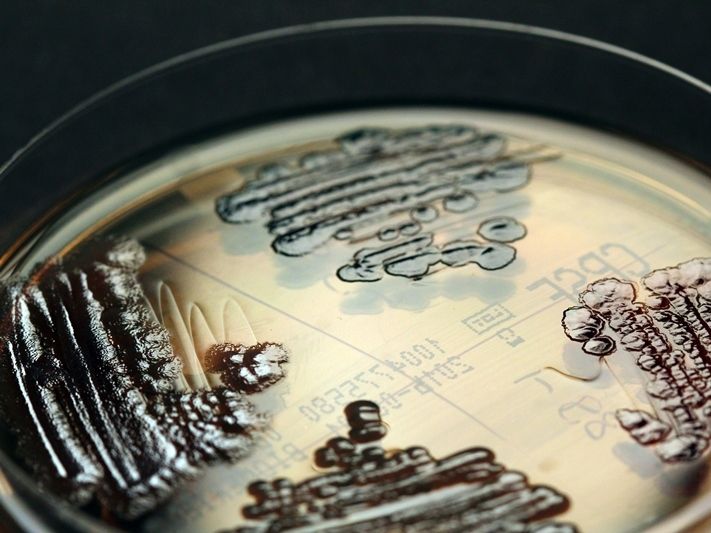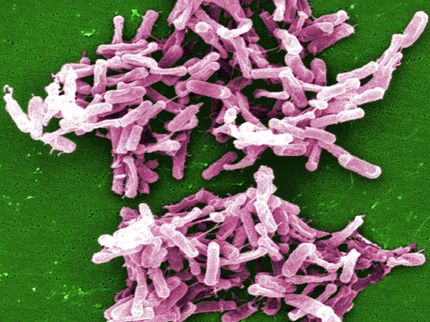How are dreaded multidrug-resistant pathogens brought into hospitals?
Advertisement
According to National Reference Center for Surveillance of Nosocomial infections esti-mates, up to 15,000 patients die of hospital-acquired infections in Germany every year. Here, multidrug-resistant bacteria, against which common antibiotics are no longer effec-tive, play a major role. But where do these pathogens come from? In largest study of its kind in Europe, DZIF scientists from the University of Cologne investigated this question and discovered that almost ten percent of patients admitted into hospitals already bring these dreaded pathogens along with them from home.

The picture shows multi-drug resistant Enterobacteriaceae in a petri dish
IMMIH, Köln/Hamprecht
"We were surprised that on hospital admission almost every tenth patient is colonised with multidrug-resistant pathogens," explains Dr Axel Hamprecht from the University of Cologne. He coordinated this study, in which six German university hospitals participated, together with Prof Harald Seifert, also from the University of Cologne, and colleagues from Charité Berlin. Over 4,000 adults were tested for multidrug-resistant Enterobacteriaceae on admission into hospital by means of stool samples or rectal swabs.
Enterobacteriaceae such as Escherichia coli constitute a normal part of the gut flora and are not pathogenic--as long as they remain in the gut. However, they can cause infections in oth-er organs, for example urinary tract infections. An infection caused by multidrug-resistant bacteria is much more difficult to treat and requires the use of last-resort antibiotics. In their investigations, the researchers paid particular attention to a group of multidrug-resistant bacte-ria that are often problematic in hospitals: so-called third-generation cephalosporin-resistant Enterobacteriaceae (3GCREB).
These multidrug-resistant gut bacteria which are resistant to cephalosporins, amongst other drugs, have spread worldwide over the past years. Similar to penicillin, cephalosporins are antibiotics that kill bacteria by inhibiting bacterial cell wall synthesis. Newer third-generation cephalosporins are effective against a broad spectrum of bacteria and belong to the group of most commonly used antibiotics. However, over the course of time, the bacteria have defend-ed themselves and have acquired so-called beta-lactamase--an enzyme that renders these an-tibiotics ineffective. Enterobacteriaceae are transmitted by smear infection, predominantly via faeces and food.
Every tenth patient brings the pathogens into hospital
Out of the 4,376 adults who were tested for 3GCREB pathogens on admission to one of the participating hospitals, 416 were carriers of these multidrug-resistant pathogens. This preva-lence is higher than has previously been reported in Germany. Especially often, the scientists found beta-lactamase producing Escherichia coli bacteria, so-called ESBL-producing Entero-bacteriaceae. The prevalence of these multidrug-resistant pathogens differed from hospital to hospital.
In order to elucidate the factors for colonisation with these bacteria, the patients completed a questionnaire on previous hospital stays and lifestyle habits. "Patients who have taken antibi-otics and travellers outside Europe are at higher risk," says Hamprecht, underlining two im-portant research findings.
Experts recommend more hygiene and using fewer antibiotics
What can be done to prevent the spread of multidrug-resistant pathogens as early as possible? Hamprecht is certain, "With so many people affected, the strategy of isolating patients within the hospitals no longer works. Additionally, in contrast to other groups of multidrug-resistant bacteria such as MRSA (Methicillin-resistant Staphylococcus-aureus) strains, standardised sanitation measures for 3GCREB have not been established." Instead, Hamprecht and Seifert recommend improving hygiene measures in hospitals and practices, a rational use of antibiotics and especially reducing their non-justified administration, as well as more training for doctors.



























































